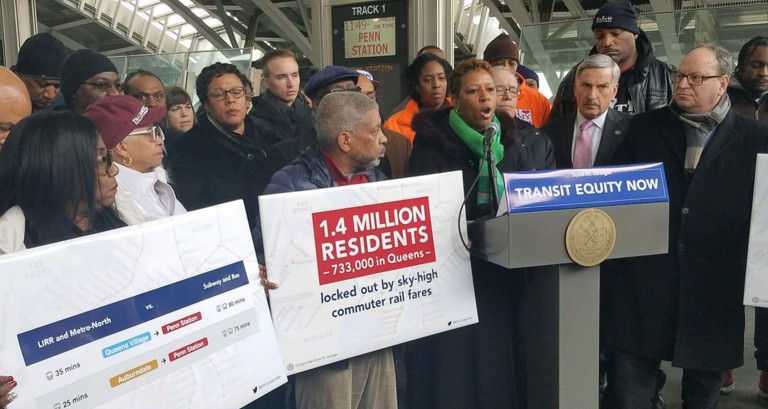Photo Courtesy of Councilwoman Adams’ Office
“Reducing the price of commuter rail fares to the price of a MetroCard in New York City zones is sorely needed for riders in transit deserts to see relief,” Councilwoman Adams said at Friday’s rally.
By Michael V. Cusenza
Borough elected officials and straphanger advocates rallied in Southeast Queens on Friday to promote a proposal that would reduce in-city commuter rail fares to $2.75, the cost of a MetroCard swipe, and allow free transfers with the subway and bus systems—effectively opening up the commuter rail system, integrating the city’s rail networks, and increasing mobility in the in the city’s fastest growing neighborhoods.
City Comptroller Scott Stringer unveiled the proposal in October when he called on the Metropolitan Transportation Authority to drop Metro-North and Long Island Rail Road fares $2.75 for all trips within the five boroughs. In his October report, “Expanding Access in One Swipe,” Stringer noted that while commuter rail stations are often the only mass transit option for the 1.4 million residents of 31 neighborhoods in Queens, Brooklyn, and the Bronx, expensive ticket prices—nearly four times as costly as a MetroCard swipe—leave locals stranded and forced to take lengthy trips on overcrowded roads, subways, and buses. Simply lowering fares and allowing free transfers between commuter rail, subways, and buses for all trips in the city would have system-wide benefits and help alleviate the transit crisis, the comptroller said.
Stringer’s analysis showed that integrating Metro-North and LIRR fares with the subway and bus would cut commute times in half, improve job access, and extend the reach of the transit system at an estimated price tag of $50 to $70 million—a fraction of the cost of new station and tunnel construction.
As part of Friday’s rally, Stringer highlighted borough-specific data detailing how lowering fares could be a game-changer for residents of the borough:
• Queens is home to the majority of commuter rail stations – 22 of the 41 across the five boroughs – which are located in close proximity to roughly 221,000 jobs and 733,000 residents.
• Expensive ticket prices force locals to make lengthy commutes with multiple transfers on overcrowded roads, subways, and buses. In total, 18 Queens LIRR stations are located in “transit deserts” beyond the subway’s reach.
• From Flushing, Hollis, St. Albans, or Laurelton to Penn Station, a one-way fare is a whopping $10.25. The fare to Long Island City, the future home of Amazon HQ2, is also $10.25.
• At the same time, much longer trips within Long Island are three-times less expensive, evidence that New York City residents pay a steep premium.
• As a result of exorbitant fares and meager service, commuters in these areas are forced to spend hours longer getting into Manhattan via subway and bus. The LIRR to Penn Station, for instance, takes 35 minutes from Queens Village and 25 minutes from Auburndale. The same trip on the subway and local bus requires 80 minutes and 75 minutes, respectively.
“Unfortunately, the MTA’s existing fee structure forces many to spend extra hours on congested subways and buses to make ends meet,” said City Councilwoman Adrienne Adams (D-Jamaica).“Reducing the price of commuter rail fares to the price of a MetroCard in New York City zones is sorely needed for riders in transit deserts to see relief.”

